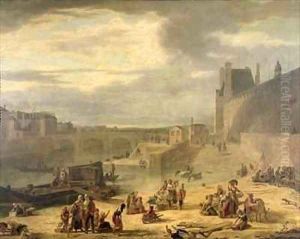J.F. De Pelchin Paintings
Jean-François de Pelchin, more commonly known as J.F. De Pelchin, was a Belgian artist born in 1825. His life spanned much of the 19th century and into the early 20th century, a period known for significant changes and developments in the European art scene. De Pelchin's work is less documented compared to his contemporaries, making his contributions to the art world somewhat enigmatic and less explored in mainstream art history.
De Pelchin's artistic endeavors were primarily focused on painting and drawing, with a particular interest in landscapes and portraiture. Living through the Romantic era and into the beginnings of Impressionism, his style was influenced by the major movements of his time yet maintained a distinct personal touch that set his work apart. The exact details of his education and training in the arts remain unclear, but it is evident from his surviving works that he possessed a keen eye for detail and a profound ability to capture the essence of his subjects.
Throughout his career, De Pelchin exhibited his work in various galleries across Belgium, gaining modest recognition among art enthusiasts and collectors. His landscapes often depicted the Belgian countryside, characterized by a vivid portrayal of natural beauty with an emphasis on atmospheric effects, likely reflecting the influence of the Romantic movement. His portraits, on the other hand, showcased a deep understanding of human emotion, capturing the personalities and inner lives of his subjects with sensitivity and depth.
Despite his talents, J.F. De Pelchin remained relatively obscure in the annals of art history. His death in 1913 marked the end of a career that, while not widely celebrated, contributed to the rich tapestry of 19th-century European art. Today, his works are cherished by a niche group of art historians and collectors who appreciate De Pelchin's unique perspective and the subtle beauty of his art.
The legacy of J.F. De Pelchin is a testament to the myriad of artists whose lives and works have been overshadowed by their more famous counterparts. His story underscores the importance of looking beyond the well-trodden path of art history to uncover the contributions of lesser-known artists. In doing so, we gain a more comprehensive understanding of the past and the diverse array of talents that have shaped the visual language of our world.
